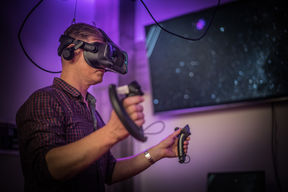New technology makes telepresence seem almost authentic

Aalto University, Tampere University and the University of the Arts Helsinki have received a research infrastructure grant of €2.4 million from the Academy of Finland for the MAGICS project. The universities will form an infrastructure network to support research into motion recording, and virtual environments. The project focuses especially on immersive and natural presence, in which the participant is made a part of a virtual world.
MAGICS uses the latest digital technology to create artistic performances, realistic games, and other remote presence solutions. The consortium is headed by Professor Mikko Sams of Aalto University, with Professor Atanas Gotchev of Tampere University as the deputy director.
‘Coronavirus has strongly raised the need for a new kind of telepresence. A telepresence that feels natural can replace physical and social meetings. Virtual technology can enable people to sit at the same table. But this all requires research and development of new technologies’, Mikko Sams says.
A concrete example of the new technology is a collaborative virtual studio project involving the national broadcaster Yle and Keho Interactive.
‘One person can be physically located in a virtual studio at Yle, and another one at Aalto Studios. The motion data from the camera can be moved from one studio to another so that the people are in exactly the same space from the viewer's point of view’, says Marcus Korhonen, technical director of the project and Director of Aalto Studios.
The team at Aalto focuses on measuring, analysing, and digitising the behaviour and experiences of people taking part in research, performances, and games in situations that are as real as possible. The team at Tampere University builds and uses virtual worlds and telepresence in game research and display technology.
‘The advantage of the joint project is that the same technology can easily be utilised to meet a variety of needs of a variety of actors. For example, the same equipment that is used in game research at the University of Tampere can be used for producing art at the University of the Arts Helsinki’, says Tero Heikkinen, postdoctoral researcher at the University of the Arts Helsinki.
The MAGICS equipment allows the researchers to precisely measure and analyse the body functions and facial expressions. The measurements help them to understand how people interact and understand each other, and what kinds of emotions emerge while, for example, playing games.
‘Visual cues, interaction, and senses can be very lifelike. Viewers can move and experience being inside a theatre performance. In addition to realistically recreated visual scenes, they can sense dampness with the help of special gloves, or they can smell synthetically produced odours’, says Atanas Gotchev.
New technology can be used in the performing arts in many ways: for example, performances can be viewed in many locations simultaneously, and scenery can be produced completely virtually.
‘We want to develop possibilities for a virtual theatre and remote presence. Virtual means of presentation have increased in recent years, and the need for them is certainly not on the decline’, says Jaana Erkkilä-Hill, Vice Rector of the University of the Arts Helsinki.
Collaboration plays a key role in the project. Shared operating models are being created with companies, services are offered, while the best practices are learned. In addition to YLE and Keho Interactive, cooperative partners include companies such as Huawei, Microsoft, Valo Motion, the Espoo City Theatre, and the Helsinki Swedish Theatre.
The MAGICS infrastructure is shared among all three campuses. The infrastructure services of Aalto University cover Aalto Studios and the Aalto Behavioral Laboratory (ABL). Infrastructure at Tampere University focuses on the Centre for Immersive Visual Technologies (CIVIT) and the Tampere Unit for Computer-Human Interaction (TAUCHI). The infrastructure of the University of the Arts Helsinki is anchored in the Centre for Artistic Research (CfAR). Physical and virtual infrastructure services are available to meet the needs of academic personnel and those of industrial product development. Infrastructure contains both stationary and movable equipment.
Further information:
Mikko Sams
Professor
Aalto University
mikko.sams@aalto.fi
Tel. +358 50 521 5739
Marcus Korhonen
Director
Aalto Studios
marcus.korhonen@aalto.fi
Tel. +358 400 129 629
Atanas Gotchev
Professor
Tampere University
atanas.gotchev@tuni.fi
Tel. +358 40 849 0733
Jaana Erkkilä-Hill
Vice Rector
University of the Arts Helsinki
jaana.erkkila-hill@uniarts.fi
Tero Heikkinen
Postdoctoral Researcher
University of the Arts Helsinki
tero.heikkinen@uniarts.fi
Tel. +358 50 528 7127
Antti Ruotoistenmäki
Coordinator of the MAGICS infrastructure
Aalto University
antti.ruotoistenmaki@aalto.fi
Tel. +358 50 408 1651
Read more news

Start the year with new insights – apply for FITech's spring courses!
Deepen your knowledge with courses from Finnish universities of technology, designed to meet the demands of the working life and help deepen your expertise for free.Growing Materials, Growing Ideas: Inside the BioMaker Studio
At Aalto University’s BioMaker Studio, initiated by Ena Naito, students and researchers experiment with living materials, from algae to mycelium, creating an open, interdisciplinary space where design, biology, and collaboration grow together.
Your voice gives away valuable personal information, so how do you keep that data safe?
With speech technologies becoming increasingly common, researchers want to make sure we don’t give away more information than we mean to.






